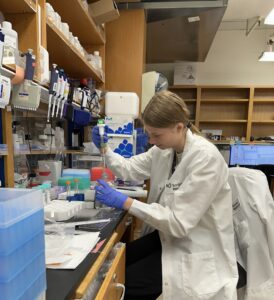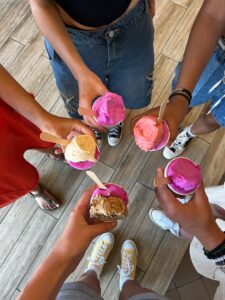Hi guys!! I’m Shiloh and for the past week (one of six!) I’ve been an intern in the Briney Lab at Scripps Research Institute in San Diego, California. Bit of context on that: the Briney Lab operates within the immunology and microbiology department at Scripps as a subsection of the Burton Laboratory. Its members work to analyze human immune responses to infectious diseases like HIV, Lassa, Ebola, and SARS-CoV-2 in order to identify and develop antibody proteins capable of effectively targeting these pathogens in a process known as “reverse vaccinology”. The overarching focus of the lab is to engineer a vaccine for the HIV virus specifically, as there is no current vaccine or definitive treatment. For the next five weeks I’ll hopefully be able to contribute to this endeavor under the guidance of grad student Nathan Liendo and doctoral candidate Sean Callaghan. As Sean will not be in-lab these first two weeks the majority of my work currently has been done with Nathan Liendo and Nathan Buetler: the official mentor of my lab partner Azari. Although we technically work in separate labs in name; the interlinked nature of the two group’s studies means we share a lab space and many of the same techniques. As Azari is also under a dual mentorship with one half absent, the present halves (the Nates) have taken to working with the two of us as a pair, taking turns teaching us their different approaches and focuses. Azari and I jokingly say they’re co-parenting us.
In the first week alone, I’ve already experienced and learned so much. Having a lab buddy is fun and makes getting lost on the first day a lot less scary. Scripps has an extensive campus and lots of tucked away paths that can make navigation hard but we found our way eventually and met up with Terrence who introduced us to the lab space and got us squared away, as well as introduced us to both Nathans. Shoutout Terrence. Funny story: Azari and I initially believed we shared a singular mentor named Nathan and were duly surprised to realize that they were in fact two separate men who, by some coincidence, both happened to be named Nathan. Writing this many iterations of the name Nathan has me mixed up now so you can imagine how difficult it is to distinguish each mentor in conversation. For the purpose of this blog my official mentor will be recorded under his last name Liendo and Azari’s mentor classified as Nate B.
After finishing our lab safety training (which was a whole technical ordeal let me tell you), we were able to jump straight into wet-work relatively quickly. A portion of the first day was dedicated to pipette training pertaining to microliter and multi-channel microliter pipettes and testing our accuracy with the help of Nate B. This quickly became a competition between Azari and me on who could get our measurements closest to perfect. Azari won. 🙁 Statistically her accuracy percentages were only better than mine by a hundred though! It was fun but more importantly both of our pipetting practices were well within an acceptable accuracy range so we were unofficially cleared to join in on more lab specific work.
Liendo introduced us to a concept known as the Central Dogma, a scientific process that makes up the very basis that the immunology labs are built upon. In short, the Central Dogma is the series of steps one takes to create a protein (in our case an antibody protein) from DNA. After all, in order to test antibody proteins one has to first acquire antibody proteins; and what better way than making them yourself? This is done by incubating DNA encoded to create the desired proteins in E. Coli Bacteria, then harvesting it and transfecting the gathered DNA into host cells that will output the antibodies we essentially engineered for testing on virus envelopes. The DNA is designed in circular rings known as Plasmids; they hold the blueprints that will ‘teach’ cells to produce the designed antibodies and we need a lot of them.
Plasmids attach very easily to bacteria since one of bacteria’s main goals is to consume. A quick heat shock opens the bacteria’s membrane allowing it to fully encase the DNA. Bacteria’s other two goals are to survive and to replicate. This works perfectly for the purposes of the lab as when provided with the perfect conditions to grow (warm, fed, and with space to roam) E Coli. multiplies rapidly, the injected plasmid inside of it theoretically multiplying as well. Before ‘growing up’ the DNA we can test it’s bacterial uptake by injecting the E. Coli cultures with a specific antibiotic; one that the DNA plasmid provides resistance against. This way any bacteria that do not adopt the DNA will die, and only those holding our desired plasmid will replicate. Once incubated the bacteria can be killed off entirely and the DNA is removed and purified through a series of buffer rinses and filters. It can then be eluted from it’s dried form to a liquid form. The bacteria does get the short end of the stick here as we essentially breed it only to literally explode it (We lyse the cell membrane to extract the DNA).
This whole process can be done to different degrees from giga to mini in order to develop the desired amount of DNA. Liendo allowed us to shadow and partially assist in a Gigaprep, the largest done in the lab and the next day Azari and I performed multiple Maxipreps ourselves under the supervision and guidance of Nate B. Now the DNA will be ready for transfection into Expi 293 host cells on Monday. We’ll eventually be expected to do this entirely on our own. It’s important to maintain sterile technique throughout your work in order to avoid cross contamination which did unfortunately occur with a DNA sequence for a heavy set chain of proteins we were attempting to develop. The sample was ruined as I forgot to check that the labels for the vial and flask of DNA solution matched. Luckily our mentors are very accepting of mistakes as they’ve all made much worse ones throughout the scope of their careers. The DNA can be regrown and a successful scientist learns from mistakes and moves on.
Throughout the week we’ve also taken a field trip to gather the salivary glands of malaria-infected mosquitos from UCSD, set agarose gels for sorting DNA, split growing host cells into their 16th and 8th passages respectively, and learned about various diseases such as Lassa virus; an immunogen found in northwestern Africa that causes hemorrhagic fever and death in those who exhibit symptoms. Liendo is studying it in part for his graduate project and it has an over 50% fatality rate in those who express the virus. One thing learned quickly about lab culture is that although we work with highly infectious and dangerous biological material; the components of our studies are often spoken about casually between immunologists. The members of the Briney Lab and Burton Lab both are generally a very laidback group who genuinely love their work and in their experience are not at all afraid of contracting the immunogens they work with. Side note: They are not afraid but you will be paranoid at all times that you have accidentally contracted a virus or bacteria of some sort and it’s not an entirely unfounded fear. The lab keeps folders on hand with pre-printed instructions for you to take to the nearest partnered hospital and show the attendants if you accidentally contract HIV on the job. Our mentors and the other lab members have all been very welcoming and kind during this first week; they crack jokes, give us tips on where we should visit on the weekends, and even bought us lunch from the weekly Thai food truck (Thanks Nate B.!). Not to mention they’re amazing teachers in the lab, even immunologists not assigned to mentor us are happy to chime in with small snippets of advice or knowledge that they have. It’s super interesting to see how they can all do the same thing in so many different ways including drawing numbers; there was an entire short segway yesterday about if sevens should be crossed and if zeroes should be drawn from the bottom or the top. (They should not be and zeroes start from the top I will die on this hill.) Both Nates have been incredibly patient with us; I think partially because watching Azari and I attempt lab practices they’ve been well-versed in for years is simultaneously entertaining and amusing for them. I’ve enjoyed my first week in the lab so so much, the days have actually flown by. We often are in the lab for over 6 hours a day and it feels like nothing, then I go home and am actually excited to take notes about the things I’ve done. I’m not normally a note-taker but the concepts we’re learning in the lab are interesting and engaging like nothing I’ve ever learned about in you average classroom. I’m beyond excited for the next five weeks in the lab and out of it as well!
Azari isn’t the only other intern I’ve gotten to know these past seven days. The San Diego team consists of three other interns spread between Scripps and UCSD: Lana, Reign, and Maiya. Having housemates is a 10/10 experience, would 100% recommend. Together, we’ve explored downtown San Diego, conquered the freeway to reach Trader Joe’s and Target, and cooked some delicious dinners alongside playing a lot of cards and backyard games. Lana currently reigns triumphant as the ping pong champion of the house. We’ve made brownies and had a movie night (do not recommend horror when you’re alone in an Airbnb), and on Saturday we went down to the beach almost the whole day. We rode some rollercoasters at Belmont park and got gelato from a local shop. It’s so fun having a built in group to hang out with outside of work and we’ve already made dozens of plans for the coming weeks!
Thanks for tuning in chat, see you next week!








So glad I get to work with you!!